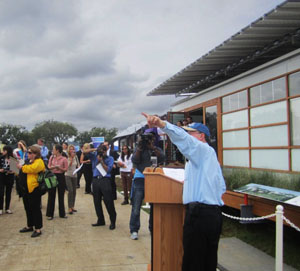DOE's solar decathlon underway, part 2
 Entry into the event is highly competitive, according to King.
Entry into the event is highly competitive, according to King.
The DOE issued a request for entries two years ago.
“To get in the event you have to write a proposal to us. We did that two years ago; we had over 40 proposals,” he said. “We pick the 20 best proposals. Then we give each of these teams $100,000 toward their projects. These are all $3-, $4-, $500,000 projects although the houses have to be $250,000. You've got communication and transport and putting students up, so the project cost is a little bit more.”
The homes themselves are docked points for being valued at more than $250,000, a first for the contest. Homes valued at that or less will receive full points in the price competition, while homes that cost more were docked points in the price category. Homes over $600,000 will receive no points for price.
In previous years, there had been no limit to spending on the homes, which led to a previous winner installing a 19 kilowatt photovoltaic array on a 1,000 square-foot home. Typical homes need solar installations no larger than 5 kilowatts.
“We encourage teams to get together with different universities,” King said.
He said by working together, schools’ specialties can complement one another.
“Maybe it’s a school of architecture, but no has engineering. Like in the case of California,” he said.
The Southern California Institute of Architecture teamed with engineers from the California Institute of Technology to produce the CHIP (compact hyper-insulated prototype) home.
CHIP had an interesting approach to insulation they called outsulation. The outsulation consisted of shredded denim insulation encased in vinyl fabric held in place with wires, making it look like a big, quilted alien pillow.
Each of the teams had to develop a home to meet a market segment, although some were more clearly purposed than others. For instance, the INhome designed by Perdue University of Indiana looked like a home ready for a suburban neighborhood, as did the entry from Tidewater Virginia.
The Maryland team focused on a home developed for living conditions in Maryland and watershed management, which is critical in the state. It also used a patent-pending desiccant dehumidifier to remove moisture from the air and the intense humidity of the mid-Atlantic.
On the other hand, the University of Illinois developed a home designed for long-term temporary relief from a disaster situation like a tornado.
Who will win the contest remains to be seen. But as of Sept. 26, Maryland’s team is winning, followed closely by Purdue’s and Ohio State’s teams.
You can check out how each team is faring as well as how much energy the solar village is producing at the Solar Decathlon’s site.
Pictured: Richard King in front of Team New York's Home. Photo: Chris Meehan / Clean Energy Authoriity.



